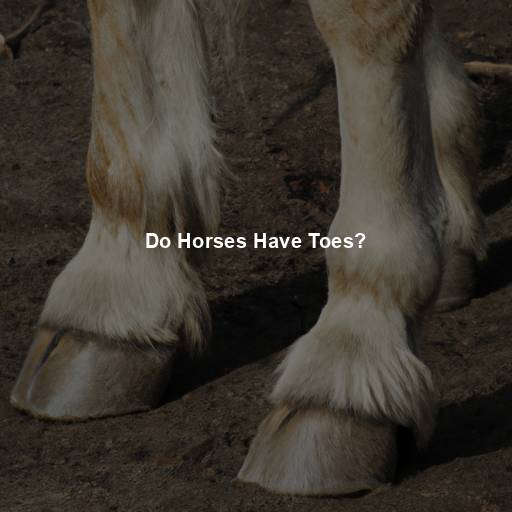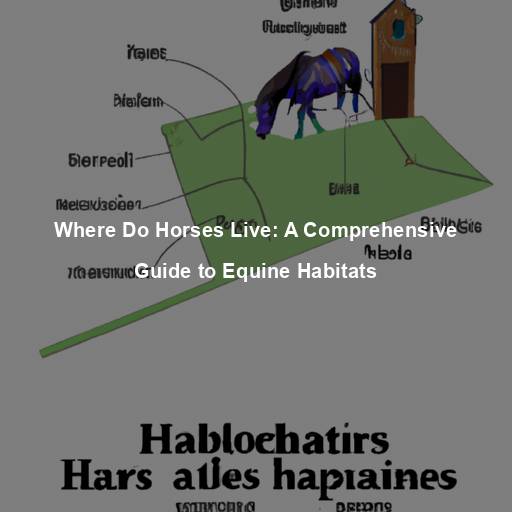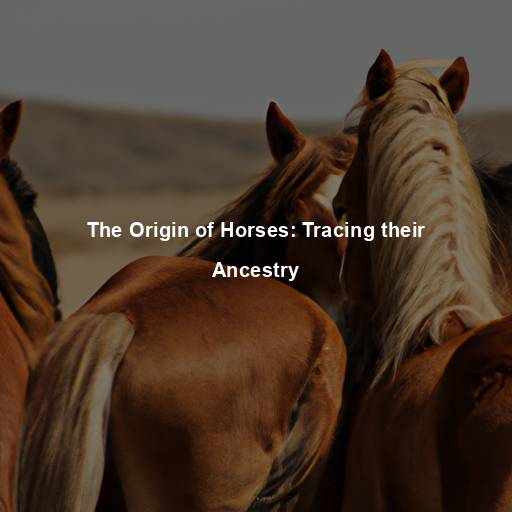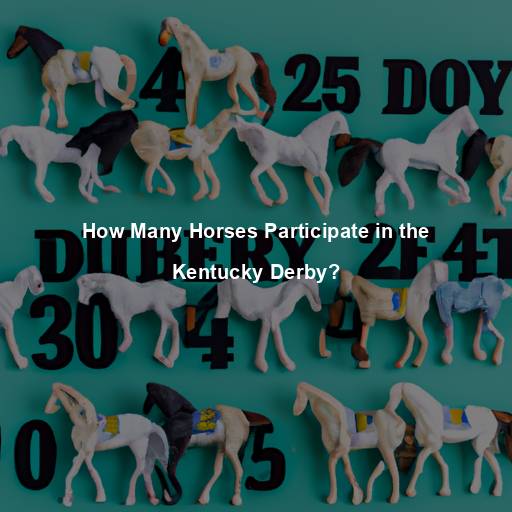Do Horses Have Toes?
Last Updated on October 24, 2023 by Evan
Contents [hide]
- 1 The Anatomy of Horses
- 1.1 Hooves: The Foundation of Equine Feet
- 1.2 The Equine Digit
- 1.3 The Evolutionary History
- 1.4 The Vestigial Remnants
- 1.5 The Function of the Hoof
- 1.6 The Importance of Farriery
- 1.7 The Fascinating World of Equine Anatomy
- 1.8 Weight Distribution and Balance
- 1.9 Adaptability and Agility
- 1.10 Shock Absorption and Protection
- 1.11 Vestigial Structures: Splint Bones
- 2 The Hoof Care Process
- 3 The Wonders of Equine Anatomy
- 4 The Fascinating World of Equine Hoof Care
- 5 The Beauty of Equine Hooves
- 6 FAQs: Do Horses Have Toes?
- 6.1 Do horses have toes?
- 6.2 How many hooves does a horse have?
- 6.3 What is the purpose of a horse’s hoof?
- 6.4 Are hooves on horses similar to human toenails?
- 6.5 Can horses feel pain in their hooves?
- 6.6 How do horses receive hoof care?
- 6.7 Are there different types of horseshoes?
- 6.8 Can horses walk or run without hooves?
- 6.9 Are all horses born with hooves?
- 6.10 Can horses wear shoes like humans?
The Anatomy of Horses
Horses, those enchanting creatures that have swirled through the depths of human fascination and ignited a timeless allure. Their lithe gracefulness and their awe-inspiring strength have bestowed upon them a universal emblem of untamed beauty and boundless liberation. Yet, even amidst this ethereal mystique, a peculiar question lingers in the recesses of our inquisitive minds: Do these celestial beings possess any hint of toes? Ah, let us embark on a captivating journey through the enigmatic anatomy of equines, where revelations await to be unveiled.
Hooves: The Foundation of Equine Feet
Delving into the enigmatic realm of equine feet, an intriguing query plagues the curious mind: do these majestic creatures indeed possess toes? By meticulously scrutinizing their profound hooves, a profound truth begins to unravel. These resilient and indispensable tools of mobility encompass the horse’s digits, bestowing upon them not only stability but also safeguarding prowess against nature’s capricious landscapes.
The Equine Digit
Now, let’s zoom in on the horse’s digit, which is the equivalent of a human finger or toe. Contrary to our five digits, horses have only one primary digit on each of their limbs. This digit is enclosed within the hoof, comprising a series of bones, joints, tendons, and ligaments. So, while horses do not possess multiple toes like humans, they do have a single toe-like structure within their hooves.
The Evolutionary History
As we delve into the intriguing world of horses, we unravel their captivating evolutionary journey. Tracing back through the annals of time, we unearth the fascinating lineage that connects these majestic creatures to their diverse ancestors. It is a cryptic tale of transformation, where the once multifarious toes of early horse precursors underwent a remarkable metamorphosis, ultimately culminating in the steadfast and resilient singular digit that defines the contemporary equine. This enigmatic process of evolution evokes a sense of bewilderment and astonishment at nature’s ingenious ability to mold and shape life throughout eons.
The Vestigial Remnants
Witness the captivating remnants of a bygone era as we delve into the enigmatic world of horses’ evolutionary past. Nestled surreptitiously alongside the majestic cannon bone, these peculiar splint bones emerge as perplexing vestiges of a time long forgotten. Once part of a vibrant symphony of toes, they now stand alone, bereft of any functional purpose in the intricate tapestry of the modern equine anatomy. Peel back the layers of history and discover the enigma of these small, inconspicuous bones, silently whispering tales of an ancient era.
The Function of the Hoof
Now that we have established that horses do have a single toe-like structure, let’s explore the function of their hooves. The horse’s hoof acts as a shock absorber, dissipating the impact of each stride and providing stability and traction. It also serves as a protective barrier, shielding the sensitive structures within the digit from potential injuries and infections. The hoof’s unique design allows horses to adapt to various surfaces, making them well-equipped for a range of terrains.
The Importance of Farriery
Maintaining the health and integrity of a horse’s hooves is crucial, and this responsibility falls into the hands of a skilled professional known as a farrier. Farriers are trained in the art of hoof care and trimming, ensuring that the hooves remain balanced, properly shaped, and free from any issues or abnormalities. Regular trimming and shoeing help prevent problems such as uneven weight distribution, lameness, and other hoof-related complications.
The Fascinating World of Equine Anatomy
The question of whether horses have toes may seem simple at first, but upon closer examination, we discover the intricate details of their anatomy. While horses do not possess multiple toes like humans, they do have a single toe-like structure within their hooves. Understanding the unique design and function of a horse’s hoof allows us to appreciate the evolutionary journey that these magnificent creatures have undertaken. So, the next time you find yourself in the presence of a horse, take a moment to admire the beauty and complexity of their equine digit, a testament to the wonders of nature.
Note: This is part one of a multi-part series on equine anatomy. Stay tuned for more fascinating insights into the world of horses!## The Significance of the Digit
Diving into the depths of equine anatomy, we unravel the enigmatic secrets behind the multifaceted digit within the majestic horse’s hoof. As we peel back the layers of complexity, a symphony of intricate structures and functions unfolds before our bewildered eyes. Prepare to be captivated by the mesmerizing significance that lies within this enigmatic puzzle of equine evolution. So, let us embark on a bewildering journey that will leave us in awe of the remarkable marvel that is the horse’s digit.
Weight Distribution and Balance
Have you ever marveled at the grace and precision with which horses move? It’s all thanks to a single, toe-like structure hidden within their hooves. This extraordinary digit, composed of bones, joints, tendons, and ligaments, plays a vital role in distributing their weight and maintaining balance. It’s fascinating how nature has provided them with such a remarkable mechanism, allowing them to navigate challenging environments with ease.
Adaptability and Agility
The digit’s design enables horses to adapt to various terrains and navigate different surfaces with agility. The concave shape of the hoof acts as a natural cup, providing better traction and stability on uneven ground. This adaptability allows horses to thrive in diverse environments, from grassy fields to rocky mountainsides.
Shock Absorption and Protection
The remarkable digit of a horse serves a vital purpose – absorbing shock. With every forceful contact of a hoof hitting the ground, this extraordinary mechanism within the digit kicks into action, working tirelessly to temper the impact. By doing so, it shields the horse’s delicate bones and joints from the perilous toll of excessive stress. In turn, this awe-inspiring shock absorption mechanism safeguards against injuries and diminishes the likelihood of enduring lameness, thus securing the horse’s enduring health and overall wellness.
Vestigial Structures: Splint Bones
As mentioned earlier, horses possess vestigial structures known as splint bones. These small, non-weight-bearing bones are remnants of the multiple toes that horses’ ancestors once had. While they no longer serve a functional purpose, splint bones can occasionally cause complications. In some cases, they may become inflamed or develop bony growths, leading to discomfort and lameness.
The Hoof Care Process
Now that we appreciate the importance of the digit within the horse’s hoof, let’s explore the process of hoof care and maintenance.
Farrier: The Hoof Care Expert
When it comes to tending to the precious hooves of our majestic companions, there is an unsung hero in the equestrian world – the farrier. These masters of hoof wizardry have dedicated their lives to perfecting the art of hoof care, meticulously trimming and shaping to preserve the delicate equilibrium of equine anatomy. Through their skillful hands, they ensure that our four-legged friends remain in the peak of hoof health, preventing any perils that may come their way. So, dear horse enthusiasts, never underestimate the importance of regular farrier visits to keep those hooves dancing with vitality.
Trimming: Balancing the Hoof
In the world of equine care, there exists a peculiar and fascinating practice known as hoof trimming. Within the confines of this therapeutic session, the farrier, with great precision and attention, embarks on a journey to sculpt and shape the hoof to pure perfection. Each stroke of their specialized tools brings forth a delicate balance and alignment that transcends mere aesthetics – it is a vital step in promoting harmony and preventing the looming specter of uneven weight distribution and peculiar gait abnormalities. A dance of craftsmanship and artistry, hoof trimming unveils a mysterious world that even the most seasoned equestrians find perplexing yet essential in nurturing the wellness of our majestic four-legged companions.
Shoeing: Extra Support and Protection
The well-being of horses can sometimes call for a helping hand when it comes to their hooves. Enter the remarkable practice of shoeing, a process where skilled farriers lend their expertise to provide a shield of support and safeguarding. By carefully securing horseshoes onto the hooves with nails, these artisans bestow that extra layer of fortification and care. The choice of materials for these horseshoes, be it sturdy steel or lightweight aluminum, is tailored to meet the diverse needs and purpose of each unique equine companion.
Monitoring and Maintenance
Ensuring optimal hoof health goes far beyond relying solely on the expertise of a farrier. Horse owners and caretakers hold a paramount responsibility in vigilantly monitoring and sustaining the well-being of their equine companions. By conducting daily inspections, one can unveil any bewildering array of potential issues – from injuries to infections – that might assail the hooves. Moreover, the diligent task of cleaning their hooves becomes an indispensable routine that rids them of encumbering dirt, debris, and the ever-menacing bacteria that relentlessly seek to thrive.
Diet and Hoof Health
The well-being of a horse’s hooves is intricately tied to its diet, with the food it consumes playing a crucial role. By providing a well-rounded and carefully balanced nutrition plan, complete with all the essential nutrients, one can pave the way for robust and thriving hooves. Seeking guidance from a trusted veterinarian or equine nutritionist can prove invaluable in devising a dietary regimen that optimally supports the health of a horse’s hooves.
The Wonders of Equine Anatomy
Delving into the captivating realm of equine anatomy unveils an enthralling tapestry of complexities and extraordinary adaptations. Amidst the graceful prowess exhibited by horses, their hooves manifest a remarkable tapestry of structural brilliance. From their singular yet multi-faceted toe-like digit, to the intricate machinery that empowers their majestic movements, these magnificent creatures never cease to astonish, forever earning our unwavering admiration and wonder.
As we explore the wonders of equine anatomy, we deepen our connection with these incredible animals. Whether you are a seasoned equestrian, an aspiring horse owner, or simply an admirer of these majestic beings, take a moment to marvel at the beauty and complexity of a horse’s hoof. It is a testament to the marvels of nature and the remarkable bond between humans and their equine companions. ## The Impact of Hoof Health on Horse Well-Being
Now that we have explored the anatomy and care of a horse’s hooves, let’s delve into the importance of hoof health for a horse’s overall well-being.
Soundness and Performance
Healthy hooves are crucial for a horse’s soundness and performance. When a horse’s hooves are well-maintained and free from issues, they can move comfortably and efficiently, allowing them to perform at their best. On the other hand, hoof problems can lead to discomfort, lameness, and a decline in performance. Regular hoof care and monitoring help identify and address any issues promptly, ensuring the horse’s continued well-being.
Prevention of Lameness
Lameness, a gnawing worry that plagues our majestic equine companions, is a conundrum frequently encountered in the realm of hooves. A perilous trio of hoof abscesses, the relentless laminitis, and the enigmatic navicular disease can unleash an insidious wave of agony and hobbling mobility if not properly addressed. By bestowing diligent devotion upon the sacred art of hoof care and forging an alliance with the valiant farrier and astute veterinarian, guardians of these magnificent creatures can embark upon a journey of preemption, shielding their cherished companions from the throes of lameness and ensuring a future of resolute well-being.
The Role of Hoof Care in Overall Horse Management
Taking care of a horse’s hooves should never be overlooked. Just like a balanced diet, consistent exercise, and regular check-ups with the vet, hoof care plays a pivotal role in ensuring the overall well-being of these magnificent creatures. Neglecting this vital aspect can have dire consequences, affecting not only their quality of life but also paving the way for more serious health complications. By giving utmost attention to hoof health, horse enthusiasts demonstrate their unwavering dedication to the longevity and happiness of their equine companions.
Early Detection of Health Issues
Maintaining the well-being of our equine companions goes beyond aesthetics – it’s a matter of their overall health. The artful hands of a skilled farrier not only shape hooves with precision but also unravel the mysteries concealed within. By forming a harmonious alliance with both farriers and veterinarians, horse enthusiasts can navigate the labyrinthine world of hoof care, ensuring that even the slightest deviations are promptly addressed, averting potential turmoil lurking beneath the surface.
The Fascinating World of Equine Hoof Care
Welcome to the intriguing realm of equine hoof care, where a harmonious fusion of scientific prowess, artistic finesse, and an intimate knowledge of equine anatomy creates an enigmatic tapestry. Today, we embark on a journey to unravel the myriad nuances that contribute to this intricate discipline. Get ready to delve deeper into the fascinating world of hoof care, where complexity and intricacy reign supreme. Join us as we peel back the layers of this enigmatic art to discover the mesmerizing secrets that lie within.
Therapeutic Shoeing
In certain cases, horses may require specialized shoeing techniques to address specific hoof issues or injuries. Therapeutic shoeing involves the use of specialized shoes, pads, or other materials to provide additional support, cushioning, or correction for the hooves. This approach can help alleviate pain, promote healing, and improve the horse’s overall comfort.
Barefoot Trimming
More and more equestrians are embracing a new trend in hoof care: going shoeless. This radical approach, known as barefoot trimming, involves bidding adieu to horseshoes and encouraging horses to embrace their natural state. Advocates passionately assert that this practice allows for optimal hoof function and overall hoof well-being. Nevertheless, seeking guidance from a skilled farrier or hoof care expert remains crucial, as each horse’s unique needs and circumstances must be carefully considered before embarking on this barefoot journey.
Advances in Hoof Care Technology
The ever-evolving world of hoof care is a whirlwind of excitement and intrigue, constantly pushing the boundaries of technology and innovation. With cutting-edge advancements like digital radiography, thermography, and even the mind-boggling concept of 3D printing customized shoes, the realm of hoof-related conundrums is being revolutionized. Prepare to be captivated by this fascinating frontier as we delve into the extraordinary possibilities these breakthroughs bring, revolutionizing the way we diagnose, treat, and prevent hoof problems. Get ready for a journey of perplexing perplexities and astonishing advances in the intricate world of hoof care.
Ongoing Education and Collaboration
Hoof care professionals, such as farriers and veterinarians, prioritize ongoing education to stay up to date with the latest research, techniques, and advancements in the field. By attending conferences, workshops, and seminars, these professionals enhance their knowledge and skills, ultimately benefiting the horses under their care. Collaboration between hoof care professionals, horse owners, and veterinarians is crucial for optimal hoof health and overall horse well-being.
The Beauty of Equine Hooves
As we wrap up our journey into the captivating world of horse hooves, it’s impossible not to be amazed by the awe-inspiring intricacies that make up these wondrous structures. The mesmerizing patterns adorning the hoof wall are a testament to the artistry of nature, while the delicacy of the frog and the resilience of the digital cushion demonstrate the remarkable adaptability that allows horses to flourish in their unparalleled habitat.
There’s something truly mesmerizing about the sight of a horse, isn’t there? Those delicate yet powerful hooves they possess are the epitome of grace and practicality. It’s as if they hold within them centuries of unspoken stories, reminding us of the deep intertwining between human and equine existence. So, the next time you come face to face with one of these majestic beings, let the intricate beauty of their hooves leave you in awe, reflecting on the enigmatic bond we share with these incredible animals.
Within the realm of equine well-being, there lies a captivating realm awaiting discovery – the realm of proper hoof care. In unraveling this mysterious world, a harmonious symphony of health, vitality, and boundless potential unfurls before us. It is a space where horses manifest their true essence, embracing their roles as stalwart companions, tireless athletes, and unwavering partners in the captivating tapestry of equestrian pursuits. Let us embark on this awe-inspiring journey, celebrating the enchanting marvel of equine hooves and the profound, indescribable connection that flourishes with each resolute step taken upon solid, meticulously nurtured terrain.
FAQs: Do Horses Have Toes?
Do horses have toes?
Contrary to popular belief, horses don’t sport an array of toes like us humans. Instead, they embrace a singular toe, known as a hoof, on each majestic limb. Crafted from keratin, a tough protein, the hoof mimics the sturdiness of our fingernails. These resilient structures ensure horses prance, gallop, and achieve remarkable equilibrium. Prepare to be fascinated by this captivating equine characteristic!
How many hooves does a horse have?
Horses, those majestic creatures with flowing manes and gentle eyes, possess a captivating feature – their remarkable hooves. Four in number, these hoofed wonders are harnessed to each of the horse’s sturdy limbs. Categorized as odd-toed ungulates, these extraordinary appendages defy the norm by boasting an odd number of toes. Masters of equilibrium and resilience, these hooves dutifully bear the weight of their noble hosts, deftly absorbing the shock of each majestic gallop and granting unparalleled grip on diverse landscapes.
What is the purpose of a horse’s hoof?
The horse’s hoof serves multiple functions. Firstly, it provides support and acts as a shock absorber, bearing the weight of the horse’s body. Secondly, the hoof helps horses maintain balance and stability while moving. Additionally, the hard outer layer of the hoof protects the sensitive internal structures of the foot, such as bones, tendons, and ligaments.
Are hooves on horses similar to human toenails?
The fascinating world of keratin holds many surprises when we compare the unique characteristics of hooves and human toenails. Despite being made from the same tough protein, these seemingly ordinary features of the animal and human form differ in striking ways. Hooves, with their impressive size and strength, play a pivotal role in a horse’s skeleton, supporting their graceful locomotion. On the other hand, human toenails, although petite in comparison, faithfully shield the delicate tips of our toes, reminding us of the intricate mechanisms that exist within our own bodies. It is truly captivating how nature crafts such diverse adaptations with a common building block.
Can horses feel pain in their hooves?
Horses, much like any living creatures, experience feelings of pain in their hooves. The intricate composition of these majestic animals’ hooves leaves room for vulnerability and susceptibility to injury. Delicate tissues, bones, and components lying within can be compromised, causing great distress. Detecting and addressing conditions such as laminitis, abscesses, or trauma becomes essential to ensure the well-being of these magnificent equines. Urgently seeking veterinary support at the first sign of trouble can help alleviate suffering and maintain their overall health.
How do horses receive hoof care?
Taking care of your horse’s hooves is absolutely paramount to ensuring its health and happiness. A crucial part of this is scheduling regular appointments with a skilled farrier who will expertly trim or shoe the hooves, keeping them in ideal condition. This meticulous process helps maintain the perfect length and shape of the hooves, allowing for proper weight distribution as your equine companion gracefully gallops through life. Furthermore, don’t forget to dedicate time to regularly examining and cleansing the hooves, as this not only helps prevent pesky infections but also provides an opportunity to detect any potential concerns before they escalate into full-blown hoof crises.
Are there different types of horseshoes?
Yes, there are various types of horseshoes available depending on the horse’s activity level, hoof condition, and terrain. Common types include flat shoes, concave shoes, or shoes with studs for enhanced traction. The choice of horseshoes depends on factors like the horse’s discipline, the type of ground it will be working on, and the recommendations of the farrier or veterinarian.
Can horses walk or run without hooves?
The question of whether horses can walk or run without hooves is often met with bewildering curiosity. It is an undisputed fact that hooves are not only integral but vital to a horse’s graceful locomotion. These exquisite structures, with their intricate composition, provide the necessary support for a horse to bear its weight and navigate its surroundings with remarkable agility. Without the steadfast protection of their hooves, a horse’s delicate bones, tendons, and ligaments would be left vulnerable to the perils of injury and strain. Hence, nurturing and preserving the health of these enigmatic appendages plays a pivotal role in ensuring a horse’s overall mobility and the preservation of its exuberant way of life.
Are all horses born with hooves?
Did you know that horses are equipped with hooves right from the moment they’re born? It’s true! Even though their hooves may not be completely solidified, foals already have the foundation for their future gallops. As they mature, their hooves strengthen and evolve, allowing them to confidently navigate the world and keep pace with their majestic mothers.
Can horses wear shoes like humans?
Horses prance with natural grace and strength, but did you know that some equines get a fashionable boost from metal horseshoes? Crafted by skilled farriers, these specialized shoes serve as a stylish shield, shielding hooves from the trials and tribulations of various activities and terrains. Of course, not every horse is smitten with the shoeing craze; factors like the intensity of their workload, the state of their hooves, and the sage advice of professionals all contribute to determining whether these trendy accessories are a hoof’s delight or meant for some other stablemate.







